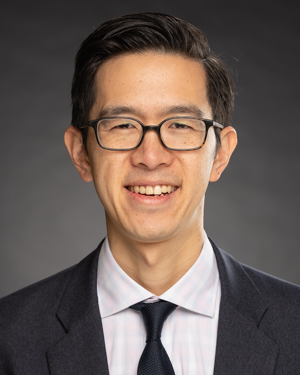Kevin Duan
Joy Lee: Why did you want to become a health services researcher studying topics at the intersection of health systems factors and pulmonary medicine?
Kevin Duan: My background from undergrad was in economics. So, since that time, I’ve always thought about how the health system worked. When I was drawn to medicine clinically as a career, all through my training, I kept seeing issues where the health system was not optimized to improve outcomes for patients or improve the patient experience and improve value for the healthcare system as a whole. So, those experiences, both my original background from undergrad as well as actual lived clinical experiences throughout my training, have really been the motivating factor that have driven me into a career of health systems and health services research.
JL: You’re currently working on a project focused on the appropriate use of in-home oxygen for Veterans with COPD. For those who are less familiar, can you provide a brief synopsis of why you’re studying this topic? Can you share any early findings?
KD: Home oxygen is something that is quite common. And COPD is a smoking-related lung disease that affects a lot of individuals – depending on estimates, upwards of 15-20 million Americans. And so, when COPD advances to a certain stage, some patients become eligible for home oxygen. And this is something that you may have seen patients in clinics, or patients – people walking around grocery stores with a nasal canula – and those are people who are on supplemental home oxygen. The use of home oxygen is something that is helpful to some patients, but is also a burdensome therapy. There are hazards to doing so including trips and falls. And so, we want to make sure when patients are receiving home oxygen therapy, that we are making sure it’s appropriate – that we are not exposing patients to the risk of home oxygen and making sure that the right people are benefitting from this therapy.
And I think home oxygen is one of those things that for many people, both in the general public and among patients, that oxygen seems like a good thing – you know, well we just put some oxygen on, and how can that be bad? But there are some risks, both some potential biological mechanisms and there are also these physical risks that I described -- trips and falls and burns related to the oxygen equipment, and the burns are specifically with people who have an open flame like people who are smoking while on home oxygen therapy. Sounds obvious that it shouldn’t be done but it occurs – I've taken good care of patients with burns related to home oxygen use and smoking. So, we want to make sure that we are optimizing the use of it so that it’s mostly appropriate.
In terms of early findings, we conducted a study in the Department of Veterans Affairs in the Pacific Northwest region. There are a number of patients that when they are discharged after what’s called the COPD exacerbation, which is when patients with COPD run into breathing issues and are hospitalized, a lot of people are discharged on home oxygen. But a lot of people don’t continue to have low oxygen levels and don’t continue to need home oxygen after they’ve recovered. So, they go into the hospital and get treated for this COPD exacerbation and get better, but many people when they’re discharged on home oxygen just get continued on this. And as we’ve talked about why I’m studying this topic, some of that news may be inappropriate and unsafe for patients with no real benefits once they’ve recovered from the exacerbation.
So, our first step has been to try to figure out whether or not people are getting reassessed. The reassessment, to be specific, is do you need to continue using oxygen? You needed it, the doctors felt like you needed it when you left the hospital, but do you still need to use it? And actually this was identified in the Choosing Wisely campaign amongst the pulmonary professional societies as something that was one of the top five of Choosing Wisely recommendations that home oxygen prescriptions that are started in the hospital after somebody has discharged should be re-evaluated within that case. And so that was the research question that we set out to investigate. And along with my colleagues at the Puget Sound VA, we found that one, we don’t do a great job of reassessing people, and among the people that are reassessed, many people actually don’t have an indication for continuing home oxygen but just continued anyway. And so, we think that there is a real potential from a health systems standpoint to make modifications there so that we are not prescribing this therapy unnecessarily and making sure that it gets in the hands of those who are really going to benefit.
JL: How does this project fit into the broader arc of your research? What’s next in terms of projects?
KD: There’s a lot to be done in home oxygen. This has been an area that has been, relatively speaking in COPD and other respiratory conditions, relatively understudied. There have been calls in the American Thoracic Society, for example, for increasing the amount of research in home oxygen. And given my interest in health systems, I’m focused on studying this health systems-related issue. So, there are a lot of things we don’t know – how we can improve appropriate therapy, how can we measure appropriate therapy, what are patient preferences? I just described to you a couple of risks that we know. We also know that there are some benefits. But how do patients weigh the risks and benefits to come to a decision about what is the best thing for them and how do they have those conversations with their providers – we don’t know anything about that. Even the risks that I’ve described to you that are quite common and everybody believes that they’re true, they haven’t been quantified in a rigorous manner at the population level. So, we have couple million people let’s say on home oxygen. How many people are falling? How many people are getting these harmful burns? We don’t know these things either. So, those are all pieces of the puzzle that I’m going to be working on in an effort to try to improve home oxygen care delivery. As you can see, I just outlined a bunch of big questions, so I think I have got a lot of work a lot of me. But there are a lot of people that are emerging with interests to study home oxygen and this particular space. So, I’m excited at what the future holds.
In addition to studying home oxygen (this is one area of pulmonary medicine), I think there are a lot of other areas of the health system that can be optimized to improve care of patients with chronic respiratory diseases like COPD. During the pandemic, we’ve seen a lot of utilization of telehealth – how is telehealth used specifically in pulmonary diseases, maybe different from how telehealth is used in other clinical areas? So, I think that’s one area of the health system that needs to be studied for patients with chronic respiratory disease.
There’s another area of interest, more long-term in terms of the question you asked about the broader arc of research – I think another area is pulmonary rehabilitation. And that is a type of therapy that’s like physical rehabilitation but for your lungs. And it has been studied in clinical trials to improve outcomes for patients. And it’s quite a useful thing, but is severely underutilized. And so, how do we optimize the health system there? How do we get more patients into pulmonary rehab? How do we make pulmonary rehab more accessible? And what would happen to the health system if we were able to do all of those things. Those are also some open questions.
So, I think beyond home oxygen, there are many other important areas that need to be studied to improve outcomes for patients with respiratory disease.
JL: It seems like the type of you work do requires substantial collaboration between people with health systems, methodological, and clinical expertise. How are you approaching building teams that collectively have that knowledge and experience?
KD: As you can imagine, this type of health systems research really requires, as you’ve pointed out, a lot of multidisciplinary work. And we’re fortunate here at the University of Washington and at the VA Puget Sound has a Center of Innovation that I’m a part of. We’re surrounded by a lot of wonderful collaborators that have all sorts of different areas of expertise. And so, the main thing that I’ve done in terms of how to build research teams that can answer these questions is to meet a lot of people, have a lot of conversations, and start to learn from all these people. And usually what happens once we start getting going is that fruitful collaborations come about relatively naturally. And it’s definitely a team sport though. My clinical perspective and some of my research training only get me so far. I work with implementation scientists, health economists, respiratory therapists – all these types of specialists are needed to paint a complete picture and conduct this type of research. As I’ve mentioned, there’s a lot of work ahead.
JL: Thank you so much for your time and telling us all about this. We’re really excited to see what happens next and to hear some of these answers to the big questions, and hope we can speak with you again.
KD: Great. Thank you so much for the opportunity. I really appreciate it.




